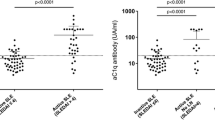Abstract
This study aimed to investigate the associations of anti-C1q antibodies with systemic lupus erythematosus (SLE) disease activity and lupus nephritis (LN) in northeast of China. Ninety patients with SLE, 37 patients with other autoimmune diseases, and 40 healthy donors in northeast of China were enrolled. Serum anti-C1q antibodies were measured by ELISA with 20 RU/ml as the threshold of positive results. The prevalence and levels of anti-C1q antibodies in SLE group (50%, 20.54 ± 34.67 RU/ml) were significantly higher than those in autoimmune disease and healthy control groups (P < 0.05), yet no significant difference between LN patients and non-LN lupus patients (57.14% vs 41.46%, P > 0.05; 25.92 ± 39.94 vs 13.07 ± 27.39 RU/ml, P > 0.05). Anti-C1q antibody levels were positively correlated with levels of Systemic Lupus Erythematosus Disease Activity Index (SLEDAI) scores, anti-dsDNA, and anti-cardiolipin and negatively correlated with serum C3 and C4 (P < 0.05). The prevalence of anti-Sm and anti-nucleosome increased in anti-C1q-positive lupus patients (P < 0.05). Compared with anti-C1q-negative lupus patients, patients with 20–40 RU/ml anti-C1q antibodies had comparable disease activity (P > 0.05); patients with 40–80 RU/ml anti-C1q antibodies had significantly lower levels of serum complement (P < 0.05); patients with above 80 RU/ml anti-C1q antibodies had much more severe hypocomplementemia, increased SLEDAI scores, and higher incidence of hematuria and proteinuria (P < 0.05). Furthermore, the specificity and positive predictive value of 80 RU/ml anti-C1q antibodies for LN was 97.56% and 87.50%, respectively. In conclusion, anti-C1q antibodies are associated with SLE and LN disease activity, and the contribution hinges on the titers. Moreover, high-level anti-C1q antibodies are valuable for diagnosing LN.
Similar content being viewed by others
References
Bowness P, Davies KA, Norsworthy PJ et al (1994) Hereditary C1q deficiency and systemic lupus erythematosus. Q J Med 87:455–464
Oelzner P, Deliyska B, Funfstuck R et al (2003) Anti-C1q antibodies and antiendothelial cell antibodies in systemic lupus erythematosus relationship with disease activity and renal involvement. Clin Rheumatol 22:271–278
Marten T, Margarita LT, Eliaka P et al (2006) High prevalence of anti-C1q antibodies in biopsy-proven active lupus nephritis. Nephrol Dial Transplant 21:3115–3121
Fang QY, Yu F, Tan Y et al (2009) Anti-C1q antibodies and IgG subclass distribution in sera from Chinese patients with lupus nephritis. Nephrol Dial Transplant 24:172–178
Chen PC, Wang CR, Liu MF et al (2002) Correlation between the renal C1q deposition and serum anti-C1q antibody: a potential role of anti-C1q antibody in lupus nephritis. Asian Pac J Allergy Immunol 20:223–227
Hochberg MC (1997) Updating the American College of Rheumatology revised criteria for the classification of systemic lupus erythematosus. Arthritis Rheum 40:1725
Li Y (2008) Lupus nephritis. In: Lu ZY, Zhong NS (eds) Internal medicine. People’s Medical, Beijing, pp 863–865
Bombardier C, Gladman DD, Hocherg M (1989) Validity and reliability of six systems for the clinical assessment of disease activity in systemic lupus erythematosus. Arthritis Rheum 32:1107–1118
Bombardier C, Gladman DD, Urowitz MB et al (1992) Derivation of the SLEDAI-A disease activity index for lupus patients. The Committee for Prognosis Studies in SLE. Arthritis Rheum 35:630–640
Siegert C, Daha M, Westedt ML et al (1991) IgG autoantibodies against C1q are correlated with nephritis, dermatitis, hypocomplementemia, and dsDNA antibodies in systemic lupus erythematosus. J Rheumatol 18:230–234
Fremeaux-Bacchi V, Noel LH, Schifferli JA (2002) No lupus nephritis in the absence of antiC1q autoantibodies? Nephrol Dial Transplant 17:2041–2043
Isenberg DA, Ravirajan CT, Rahman A et al (1997) The role of antibodies to DNA in systemic lupus erythematosus—a review and introduction to an international workshop on DNA antibodies held in London May 1996. Lupus 6:290–304
Lloyd W, Schur PH (1981) Immune complexes, complement, and anti-DNA in exacerbations of systemic lupus erythematosus. Medicine (Baltimore) 60:208–217
Inanc M, Donohoe S, Ravirajan CT et al (1998) Anti-beta2-glycoprotein I, anti-prothrombin and anticardiolipin antibodies in a longitudinal study of patients with systemic lupus erythematosus and the antiphospholipid syndrome. Br J Rheumatol 37:1089–1094
Amoura Z, Piette JC (2003) Role of the nucleosome in the physiopathology of systemic lupus erythematosus. Ann Med Interne (Paris) 154:25–32
Horvath L, Czirjak L, Fekete B et al (2001) High levels of antibodies against Clq are associated with disease activity and nephritis but not with other organ manifestations in SLE patients. Clin Exp Rheumatol 19:667–672
Siegert CE, Daha MR, Tseng CM et al (1993) Predictive value of IgG autoantibodies against C1q for nephritis in systemic lupus erythematosus. Ann Rheum Dis 52:851–856
Coremans IE, Spronk PE, Boots ma H et al (1995) Changes in antibodies to C1q predict renal relapses in systemic lupus erythematosus. Am J Kidney Dis 26:595–601
Moroni G, Trendeleburg M, Del PN et al (2001) Anti-C1q antibodies may help in diagnosing a renal flare in lupus nephritis. Am J Kidney Dis 37:490–498
Gunnarsson I, Sundelin B, Heimburger M et al (2002) Repeated renal biopsy in proliferative lupus nephritis-predictive role of serum C1q and albuminuria. J Rheumatol 29:693–699
Horak P, Hermanova Z, Tichy T et al (2006) C1q complement component and antibodies reflect SLE activity and kidney involvement. Clin Rheumatol 25:532–536
Sinico RA, Radice A, Ikehata M et al (2005) Anti-C1q autoantibodies in lupus nephritis: prevalence and clinical significance. Ann NY Acad Sci 1050:193–200
Botto M, Walport MJ (2002) C1q, autoimmunity and apoptosis. Immunobiology 205:395–406
Barilla-LaBarca ML, Atkinson JP (2003) Rheumatic syndromes associated with complement deficiency. Curr Opin Rheumatol 15:55–60
Pickering MC, Botto M, Aylor PR et al (2000) Systemic lupus erythematosus, complement deficiency and apoptosis. Adv Immunol 76:227–334
Holers VM (2004) Anti-C1q autoantibodies amplify pathogenic complement activation in systemic lupus erythematosus. J Clin Invest 114:616–619
Disclosures
None
Author information
Authors and Affiliations
Corresponding author
Rights and permissions
About this article
Cite this article
Zhang, CQ., Ren, L., Gao, F. et al. Anti-C1q antibodies are associated with systemic lupus erythematosus disease activity and lupus nephritis in northeast of China. Clin Rheumatol 30, 967–973 (2011). https://doi.org/10.1007/s10067-011-1698-1
Received:
Revised:
Accepted:
Published:
Issue Date:
DOI: https://doi.org/10.1007/s10067-011-1698-1



